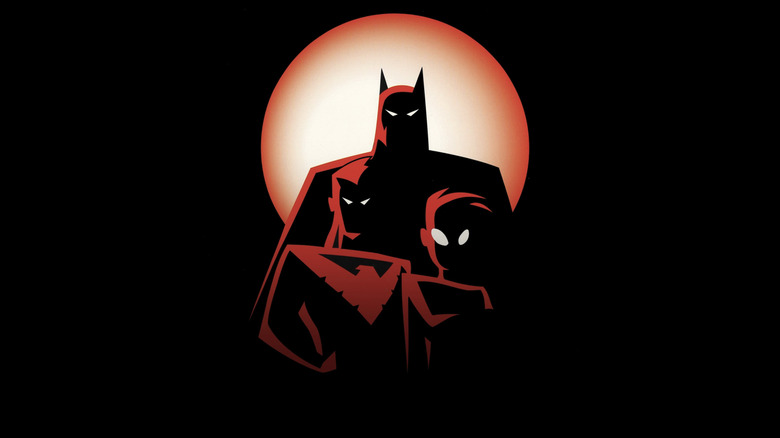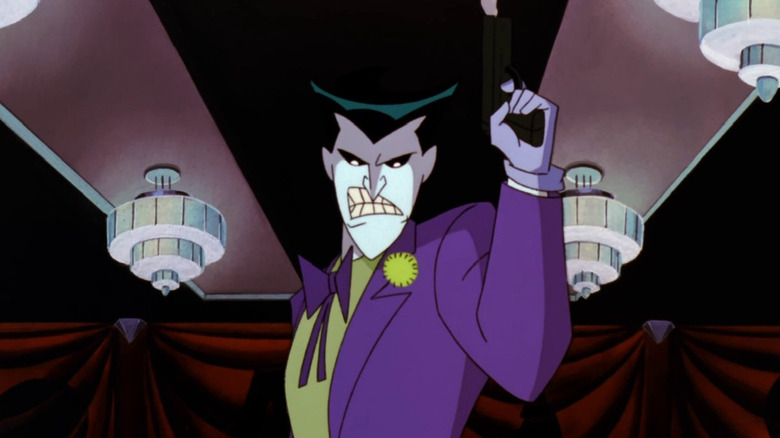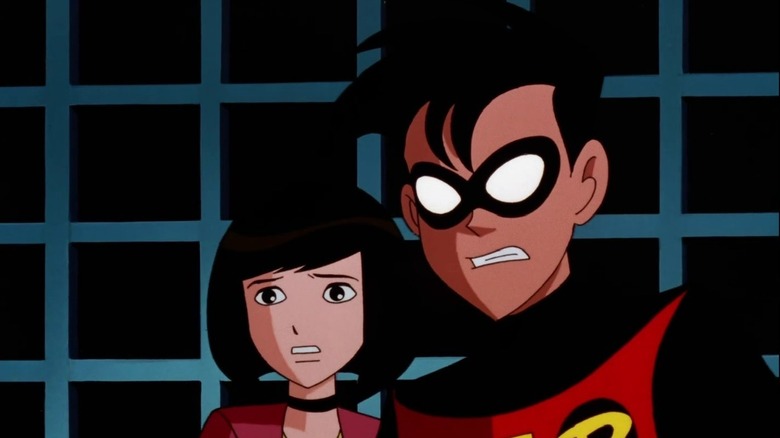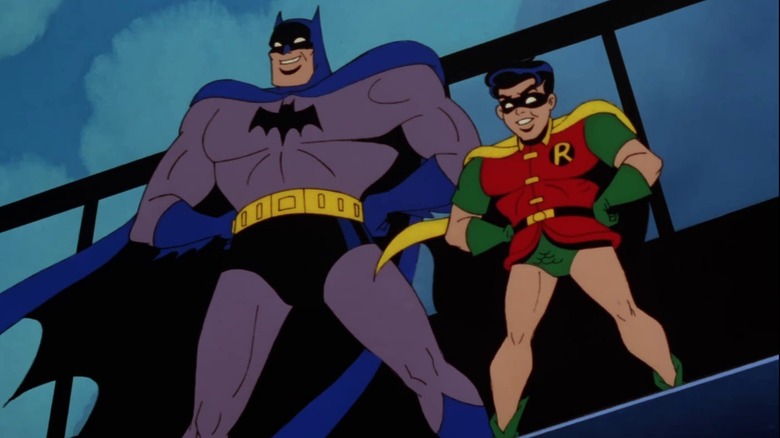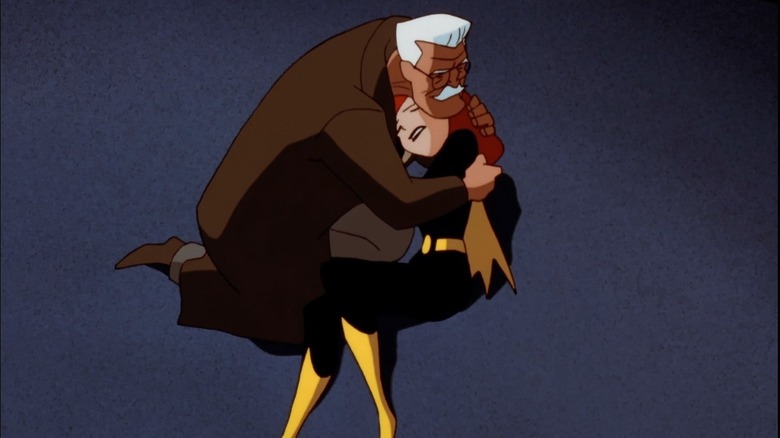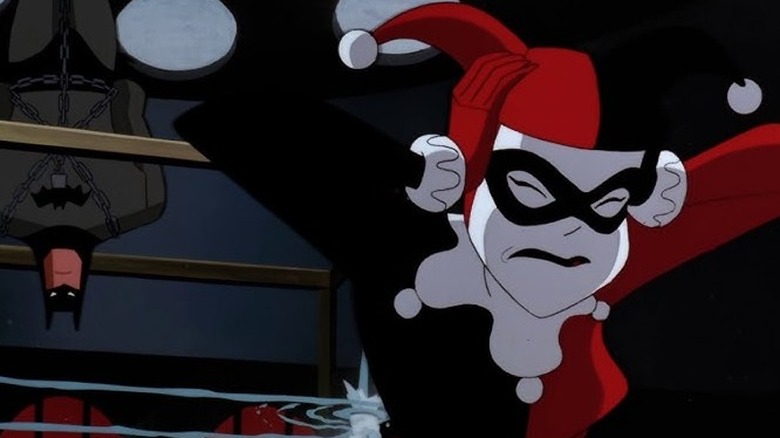The 5 Best New Batman Adventures Episodes, Ranked
"Batman: The Animated Series" kept getting second leases on life. After running the syndication-required 65 episodes (the absolute most that cartoons often got back then) from 1992 to 1993, the series got 20 more episodes the following year. Rebranded as "The Adventures of Batman & Robin," this back 20 has some of the all-time best "Batman" TV episodes: "Trial," "House and Garden," "Harlequinade," "Harley's Holiday," and "Baby Doll." I shudder to think of a world without them.
After wrapping for real in 1995, Batman returned to television a mere two years later. "The New Batman Adventures" was a sequel to "The Animated Series," with the same core voice cast and crew. Some fans and official releases even label "Adventures" as just another season of "The Animated Series." The show's styles and settings, though, are different enough to stand apart.
"New Batman Adventures" aired on Kids WB, rather than Fox Kids. The writers claimed in a Wizard Magazine interview that WB were much less stringent censors than Fox, and indeed "Adventures" often pushed some risque envelopes more. The writers also acknowledged the hiatus; two years had passed in-universe as well and things had changed in Gotham. Robin (Loren Lester) had quit being Batman's sidekick and become Nightwing. Barbara Gordon (Tara Strong) went from two-time guest star to a full-time Batgirl. In the early episode "Sins of the Father," Batman adopts the orphan Tim Drake (Mathew Valencia) as the new Robin.
The result was a full-on Bat-Family — but while Batman was now less of a loner, he was also more broody. Kevin Conroy stopped using the lighter voice he had for Bruce Wayne in "The Animated Series," suggesting Bruce's Batman side was fully taking over. Batman's costume was also redesigned to remove the blue highlights and the yellow oval around the chest Bat-symbol.
In general, "New Batman Adventures" underwent a major stylistic overhaul, ditching the retro 1940s style of "Batman: The Animated Series" for a sleeker look. Some might call the new look flatter; the character designs were sharper and less expressive, and while the color palette was still dark (Gotham had an inexplicably red sky), the lighting design was more simplistic.
While the stylistic changes remain controversial, the writing was still top notch. Of the 24-episode run of "New Batman Adventures," these are the best stories.
5. Joker's Millions
The Joker's lipless redesign is generally the most disliked of the "New Batman Adventures" redesigns, and it's definitely nowhere near as scary as the original look. Still, the "Batman" crew knew if they put Mark Hamill in the recording booth, he'd have no problem carrying the episode as the Joker.
Adapted from a 1952 comic of the same name, "Joker's Millions" is a straight-up comedy — a damn fine one. When the episode opens, the Joker is flat broke; fighting Batman is an expensive hobby. The opening sequence sees Joker and Harley Quinn's latest robbery hit constant cost-driven speed bumps. First they expend all their bullets, then their getaway car runs out of gas, and finally, the Joker leaves Harley for the fuzz because he could only afford one rocket booster escape chair.
The Joker soon discovers, though, that his gangland rival "King" Edward Barlow has inexplicably left him a $250 million inheritance. The Joker decides to retire, using his fortune to buy his way to exoneration and high society. As a law-abiding clown, though, the Joker now has to pay his taxes (revealed with the classic bit that even the Joker is scared of the IRS).
That's how the Joker learns that Barlow played a prank on him from beyond the grave. All but the first $10 million (which the Joker wastefully spent) is counterfeit, now he must either publicly admit he's a fool or face prison, this time for tax evasion. Needless to say, by the episode's end the Joker is back in a paddy wagon headed straight to Arkham. Riding with him is Harley, who's angry he didn't buy her freedom and is eager to "welcome [him] to the club."
4. Growing Pains
At the exact opposite end of the light/dark spectrum as "Joker's Millions" sits "Growing Pains," where Tim Drake gets his first lesson that even a superhero can't save everyone.
The episode opens with a young girl named Annie (Francesca Marie Smith) running through the dark streets of Gotham, being chased by a gang before Robin saves her. Annie has no memory of her past, but she feels a compulsion to run, which Robin soon learns is because a mysterious man is chasing after her. The man claims to be her father, but even though she's terrified of him, he's not lying — mostly.
You see, Annie's "father" is Matt Hagen, aka Clayface (Ron Perlman). "Annie" is a piece of his shapeshifting body that broke off after his last encounter with Batman. The split made her develop instincts and will beyond Hagen's own, and he wants to absorb her back into himself to make his body whole again. In the third act, he succeeds. Robin, who'd been trying to get Annie to safety and developing some shared puppy love, takes her death very hard. Powerless to bring her back, he asks only that Clayface be charged with murder: a lesson to kids that even justice can't always heal the hurt of an unfair loss.
The comic book fantasy of it all aside, "Growing Pains" is basically a story about a boy trying to help a girl escape her abusive father — and failing. "Batman: The Animated Series" is a kids show at the end of the day, but in episodes like "Growing Pains," the creators showed how children deserve affecting stories as much as adults do.
3. Legends of the Dark Knight
"Batman: The Animated Series" and "New Batman Adventures" often used the hero himself as supporting character. These episodes would tell stories from the perspective of ordinary Gothamites whose lives briefly intersected with Batman's. One of the most unique examples is "Legends of the Dark Knight." The title is cribbed from an ongoing Batman anthology comic, one that would swap writers/artists every couple issues to let new team after new team tell a short Batman story.
It's a perfect name for the episode, which follows three kids in Gotham City who share stories they've heard about Batman. One of them, Matt, recalls how his uncle supposedly witnessed Batman and Robin stop the Joker from robbing a museum. The episode jumps to a sequence modeled on the brightly-colored, semi-surreal 1950s Batman comics. Every line of dialogue is a pun, Batman and Robin have bodybuilder physiques and postures you can only get from a stick up your behind, the museum is filled with 30-foot-tall instruments, and the Joker (voiced by Michael McKean instead of Hamill) is a mere troublemaker, not a psychopath.
Then Matt's friend Carrie, a familiar looking red-haired girl with glasses, tells a different story about a brutal, hulking Batman (voiced by Michael Ironside) and his girl sidekick Robin. This segment, of course, adapts Frank Miller's "The Dark Knight Returns," the definitive "gritty Batman" comic. (Finger, Sprang, and Miller are all credited in the opening titles.)
Like comics, cartoons can present the same characters in widely different art styles, all with a simple cut from one frame to the next. "Legends of the Dark Knight" takes advantage of that while honoring Batman's history. The episode itself, and the real Batman the kids meet at the end, is just another story — no more or less valid than the in-universe ones the kids share.
2. Over The Edge
The best "New Batman Adventures" redesign was without a doubt Jonathan Crane/The Scarecrow, who now looked more like Leatherface than like Ray Bolger in "The Wizard of Oz." The producers also recast, bringing in Jeffrey Combs of "Re-Animator" fame to play the villain in his re-introduction episode, "Never Fear."
"Never Fear" is a great episode, but after carefully weighing it, I have to give this spot to the other Scarecrow episode of "New Batman Adventures" — "Over The Edge." The episode begins with Commissioner Gordon and the GCPD chasing Batman and Robin through the Batcave. The cops have learned Bruce Wayne's secret identity and now want to bring him in. It's a bold opening, a relentless chase scene that makes you instantly ask what the heck is going on.
You see, while the Bat-family was fighting Scarecrow and his gang, Crane got the best of Batgirl and knocked her off a skyscraper to her death. Commissioner Gordon, enraged at his daughter's murder and how Batman let Barbara put herself in danger, severed their alliance and is going to capture the Bat.
Or, not. The Scarecrow didn't really kill Barbara, he just knocked her out with his fear toxin. The whole episode has been her greatest nightmare brought to life: that if she died in the line of duty, it would set her father and her mentor on a path of mutually assured destruction.
Now, "all just a dream" is always a cheap twist, but I think it's used acceptably here. The premise of the episode, a worst case scenario for Batman, is too tantalizing to not explore. It could only happen in an "imaginary" episode, though, since this is a cartoon series that needs to maintain a workable status quo. Plus, the episode wisely telegraphs its ending by using Scarecrow, a villain whose whole shtick is causing terrifying hallucinations.
1. Mad Love
Bruce Timm and Paul Dini are undeniably in the pantheon of important Batman writers/artists for their work on "Batman: The Animated Series." Their signature, and most unexpected, success is the creation of Harley Quinn. After featuring her as the Joker's wacky sidekick in several episodes, the pair decided to tell her backstory in the "Batman Adventures" tie-in comic.
"Mad Love" (published in 1993, written by Dini, drawn by Timm) revealed how Harley was once Harleen Quinzel, a psychiatry intern at Arkham who was seduced by the Joker. In the present day, Harley has to reckon with how her "love life" is a toxic rut, but will she listen? The comic peels away some of the humor to show how the Joker and Harley are in a textbook abusive relationship, and that is never played for laughs.
A few years later, Timm and Dini adapted "Mad Love" into a "New Batman Adventures" episode. It's very faithful; even if the comic had some more mature moments the cartoon couldn't, the story's power is unmitigated in adaptation. Some moments are even more effective in the episode. Near the climax, Batman laughs at Harley's belief the Joker loves her and tries to wake her up to his lies. This works better in the cartoon because you can hear the laughter and how pained Harley's denials are. (Courtesy of the late, great Arleen Sorkin.)
"Mad Love" was the last aired episode of "The New Batman Adventures" — it's hard to imagine a higher note for the series to close on.
